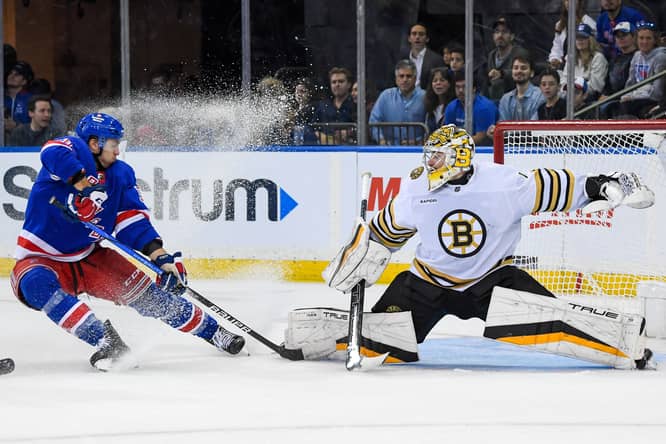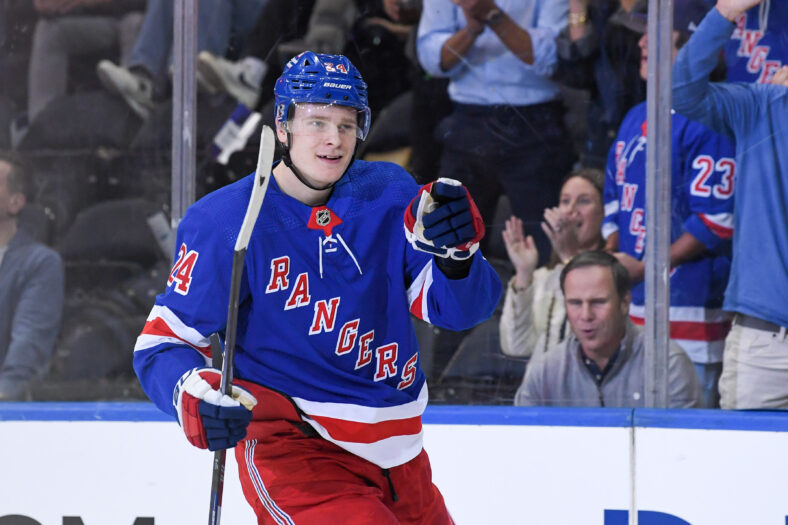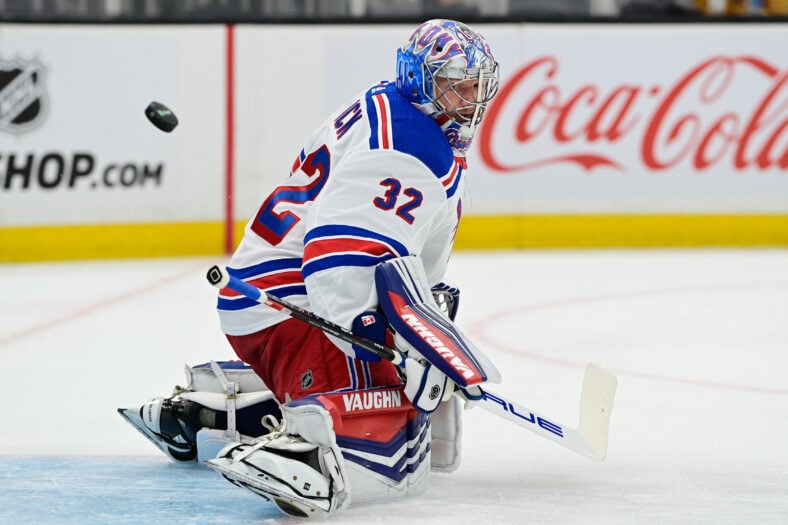The good, bad, and ugly of the New York Rangers preseason

This campaign’s preseason results, a 1-5-0 record, are already a memory the New York Rangers would like to forget. Nevertheless, like all things, there’s some good, bad, and in this case, ugly to reflect upon.
We believe it’s always better to begin with the good about a team’s performance. Hence, we’ll offer up positive aspects observed over the six preseason games played by the Blueshirts this year, followed by the not so good.
Related: New York Rangers lineup projections
New York Rangers Preseason: The Good

The prospects are shining bright
Coming into training camp, the Rangers counted among their participants a decent number of prospects, some of whom were battling to make the roster with the NHL team and some of whom were just being given a look.
Most impressive was forward Will Cuylle, who played in five of the six preseason games. The 21-year-old totaled two goals, one assist, twelve shots on goal, and a +1 rating in those matches. He averaged 15:50 minutes ice time and about 20 shifts per game, with 12 hits and only three giveaways. His play absolutely forced his way on to a roster many believed was practically set in July after free agency.
“He was noticeable all the time,” coach Peter Laviolette said of Cuylle. “He did a lot of things out there consistently in camp and earned himself this opportunity.”
Zac Jones, extended for two years by the Blueshirts in the offseason, also made the team as the seventh defenseman. Although his play was strong, the Rangers were not going to waive the 22-year old, and risk losing him for nothing.
Several other prospects impressed, with forward Brennan Othmann being given the most looks and playing in five games, totaling two goals on six shots. Additional prospects to note were forward Matt Rempe, defenseman Matthew Robertson, and goaltender Dylan Garand, who have all now been assigned to AHL Hartford, but whom all look to have promising futures in the NHL.
Peter Laviolette’s new system
Learning a new system was anticipated to be challenging for a team mostly composed of veterans who’ve been playing their own way for a long time.
But in the spurts we saw of the system actually working, it looked effective when actually being implemented. Despite losing to the Boston Bruins last Thursday, the first period was one of the best periods of the preseason for the Blueshirts, and the speed, two-way play, and improved puck control were noticeable.
The recent core group of Rangers have never been of the speedy north-south style of play, and it’s not clear we’ll ever see multiple rushes per period from this roster. But the practices under the new system have been challenging, and eventually some of what the veteran coach is trying to teach will probably take hold in a more sustained way.
Laviolette, overall, thought Thursday’s first period was good; but also believed the Blueshirts got “a little bit too much east-west” after that. He made it clear he’d like to see more offense generated. Said the head coach: “In general, I’d like to take it more down the ice as opposed to across the ice… Just playing a bit more north.” The coach did also state that he’s seen improvement defensively in the team since the start of training camp.
Maintaining that play style consistently for three full periods is the most critical challenge to be overcome.
Forward lines and defensive pairings
Due to injuries and trials of different combinations, the forward lines have been modified for every game; yet some lines look to be the ones that will start the season exactly as they were on Thursday.
In particular, the top line of Chris Kreider, Mika Zibanejad, and Kaapo Kakko looked to really mesh in the final preseason game, with Kakko scoring early on a beautiful pass from Kreider. Kakko looks to be coming into his own as a player, and that’s another thing to consider promising coming out of this preseason.
Vincent Trocheck anchoring a third “checking” line seems to be working, and we can expect to see that at the start of the regular season, as well.
Although the new head coach has played around a bit with the defensive pairings, the Ryan Lindgren-Adam Fox and K’Andre Miller-Jacob Trouba top two pairs will probably be the ones to begin the regular season. On the third pairing, Erik Gustafsson, newly acquired in the offseason by general manger Chris Drury, has worked with a number of defensemen in the preseason. His contributions to keeping the puck in play for the offense and in playing sharp defense have been noticeable. He will likely be paired with Braden Schneider to begin the season.
New York Rangers Preseason: The Bad

Backup goaltending
At the end of the 2022-2023 season, the Rangers didn’t re-sign backup net minder Jaroslav Halak, who had eventually proven himself to be reliable, if not outstanding.
Instead, they signed veteran goaltender Jonathan Quick, who had already begun to decline in effectiveness during his recent time with the Los Angeles Kings and Vegas Golden Knights last season.
Quick has looked very rusty in camp, which would be expected from any veteran goalie who hadn’t seen a real game situation in months. But the number of goals the veteran would probably say he should have kept out, even in this short preseason stint, is not making his early regular season games look optimistic.
In 3 preseason appearance, Quick posted a 5.08 GAA with a .807 SV%. Rangers goalie coach Benoit Allaire has a lot of work to do.
Consistency of play
As we’ve already indicated, the Rangers looked in this preseason to be lapsing back into one of their issues from last season — lack of sustained consistency for three full periods.
In the games in which they started off strong, they had a difficult time maintaining the new system throughout the game. The first two games of the preseason seemed a bit better in that regard — but those were also the games in which many players who’ve now been cut from the roster were active.
“From a defensive standpoint, there’s a couple of chances in the third period I just didn’t like,” stated Laviolette after Thursday’s game. “On the (game-winning) goal, we had everybody back, we just didn’t defend it very well.”
The head coach also said, “there’s work to be done on everything.”
In the games in which the Blueshirts made a push at the end to tie or win, it probably shouldn’t have come down to needing that final effort. Had the special teams play been stronger (we’re getting to that) and the backup goaltending been better, some of these last-minute gasps might not have been necessary. No matter what game system was being used.
New York Rangers Preseason: The Ugly
Special teams
It would be difficult not to point out how ineffective the Rangers’ special teams were this preseason. Last in the NHL on the penalty kill, they came in at 60.0% (6 for 15). Next to last on the power play, they came in at 4.8% (1 for 21).
What was a strength for the Blueshirts a mere two years ago — their power play scoring — has devolved into a weakness that must be overcome. Visible already in last season’s declining power play numbers, slightly above league average at 24.08%, this preseason did not have the team looking like the offseason refreshed that aspect of their game at all.
“The first part of camp, you’re focused on the 5-on-5 play and not so much the [special teams],” Laviolette admitted after Thursday’s game. “These guys have been together (on the PP) so there’s a little more rhythm. The penalty kill is a little bit new and different, so they’re figuring it out.”
It might be time to make some radical changes to the style of power play used by the veterans on the team; but as the head coach explained, they’re also working on a new type of penalty kill — and it showed.
The Rangers begin the regular season in Buffalo on October 12th, and in the time between now and then, they’ll try as much as possible to work out some of these kinks.
More About:New York Rangers Analysis New York Rangers News
